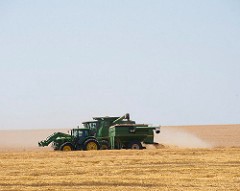June 12, 2018
Kansas Net Farm Income Climbs, but Still Far Below Three Years Ago

Kansas net farm income rose in 2017 for the second straight year, thanks in part to stronger livestock prices, but was still less than half what it was just three years earlier.
Net farm income statewide averaged $62,944 in 2017, up about $16,000 from a year earlier.
“There is much variability between farms, including differences in production ranging from record yields to drought, as well as differences in financial position and cost structure, and differences in decision-making and management of risk,” said Kevin Herbel, executive director of the Kansas Farm Management Association. The data is derived from a summary of the records of KFMA program members. Though not all farms across the state are KFMA members, the summary information provides a glimpse of the financial picture for Kansas farmers.
“While net income increased for the average farm, 31 percent of the farms had negative net income for the year,” Herbel added. “The current financial position for KFMA farms continued to erode in 2017, a reflection of the tightening cash position faced by many farms,” he said. This indicated that the average current ratio has decreased each year since 2012 and is currently at $2 of current assets for each $1 of current liabilities, the lowest level since 2001.
Crop production costs and machinery costs decreased slightly during the year, helping the net income position. With tight margins and cash-flow constraints, KFMA member farms have updated less machinery and equipment in recent years with machinery investment down more than $20 per acre after reaching a peak in 2014.
Grain prices continued at levels that created tight margins for much of the year, which weighed on farm income, Herbel said, but occasional price rallies provided selling opportunities. Also on the plus side, the value of livestock produced increased 31 percent for the average farm – particularly resulting from those with cow-calf herds and involved in cattle feeding.
"Government payments had an impact by supporting net incomes around the state,” he said. Average government payments per farm were $27,689 which was 44 percent of the $62,944 net income. Around the state the percent of net income ranged from 17 percent in southeast Kansas to 124 percent in south central Kansas, where government payments were $37,964 and net farm income $30,517."
Farm type and location
As is typically the case, income varied widely from one part of the state to another, and by type of operation.
Average Kansas farm income, by region:
– Southeast: $102,671.
– Northwest: $94,071.
– Southwest: $78,092.
– Northeast: $54,418.
– South central: $30,517
– North central: $28,950.
Average net income on Kansas farms, by operation:
– Background cattle (the intermediate stage of cattle production between weaning and feedlot): $228,202.
– Crop farms with 20 to 60 percent irrigated acres: $101,102.
– Dairy: $81,003.
– Crop farms with more than 60 percent irrigated acres: $75,070.
– Dryland farms at $53,658.
Recordkeeping
"Keeping accurate records and benchmarking with those records to identify strengths and weaknesses can help agricultural producers focus their management efforts," Herbel said.
“These records can help identify production costs, provide a starting point for market planning, and help a farm manager understand the farm business better than anyone else,” he said. “The investment of time into this process is important to manage today’s economic environment successfully.”
Links:
KFMA website: www.AgManager.info/KFMA
Radio interview on this topic: http://agtodayksu.libsyn.com/report-2017-kansas-net-farm-income-agriculture-today-may-10-2018